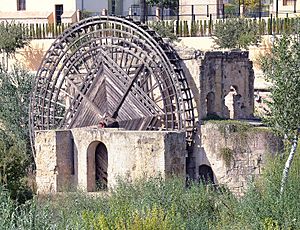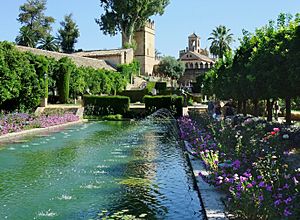Alcázar of the Caliphs (Córdoba) facts for kids

The Alcázar of the Caliphs was a huge palace and fortress in Córdoba, in what is now Spain. It was also called the Umayyad Alcázar or Caliphal Alcázar. For many centuries, from the 700s to the 1200s, it was the main home and government center for the Muslim rulers of Al-Andalus. These rulers were called emirs and later caliphs.
The Alcázar was a large complex with many different buildings. It had private homes for the rulers and their families, plus offices for the government. Today, most of the original palace is gone. Only small parts remain, like the Caliphal Baths, which are now a museum. Other buildings, like the Alcázar de los Reyes Cristianos and the Episcopal Palace, now stand where the old Alcázar once was.
Contents
History of the Alcázar
When the Visigoths were defeated by the Muslims in 711, a new era began in Spain called Al-Andalus. At first, the Muslim governors lived in Seville. But in 717, the capital of Al-Andalus moved to Córdoba, which used to be the Visigothic capital. The governor then moved into the old palace of the Visigothic king. This palace was close to the Roman bridge and the city's first mosque.

In 750, the Umayyad rulers were overthrown by the Abbasid Caliphate. But a member of the Umayyad family, Abd ar-Rahman I, escaped to Córdoba. In 756, he started a new Umayyad kingdom in Al-Andalus, called the Umayyad Emirate. Abd ar-Rahman I first lived in palaces outside the city. But after a plot against him in 784, he moved into the city palace. He then began to transform it into the grand Alcázar. A year later, he also started building the Great Mosque right next door.
Abd ar-Rahman I and the rulers who came after him (who later became caliphs) kept building and improving the Alcázar. It became the official royal home and the center of power in Al-Andalus. During this time, Córdoba became a very important city for politics and culture. The Alcázar grew to be a huge area with baths, beautiful gardens, and one of the biggest libraries in Western Europe.
Abd ar-Rahman II made sure the palace and its gardens had enough water. He might have built the Albolafia and other waterwheels along the Guadalquivir River. The palace also had a bathhouse (called a hammam), known today as the Caliphal Baths. These baths were built around the time of Caliph al-Hakam II.
In the 900s, the main government moved to a new palace complex called Madinat al-Zahara, built by Caliph Abd ar-Rahman III outside the city. Even so, the original Alcázar in Córdoba remained important. Abd ar-Rahman III also did a lot of work there, adding new water systems and possibly a "Garden House" near the royal cemetery.
Madinat al-Zahara was later destroyed when the caliphate fell apart in the early 1000s. Because of this, the center of power returned to the Alcázar in Córdoba. Local governors lived there under later rulers. In 1236, the Christians, led by Ferdinand III, conquered the city. Part of the Alcázar was given to the bishop of Córdoba and became the Episcopal Palace. A large part was turned into the Alcazar of the Christian Kings, which is still there today. Only a few parts of the original Islamic palaces remain.
What the Alcázar Looked Like
Location and Size
The Alcázar complex was very large. It was located southwest of the Great Mosque. Today, this area includes the Alcázar de los Reyes Cristianos, the Episcopal Palace, and a public square called Campo Santos de los Mártires. The entire palace complex was surrounded by walls and covered an area of about 39,000 square meters.
The palaces were connected to the Great Mosque by a high, covered walkway called a sabbat. This walkway went over the street, allowing the caliph to go directly from the palace to the mosque for prayers. The first sabbat was built for safety reasons by Emir Abdallah. It was later replaced by Caliph al-Hakam II when he made the mosque bigger.
Gates of the Palace
We know some details about the Alcázar's layout from old historians. They mentioned several important gates in its walls.
- Bab al-Hadid ("Iron Gate"): This gate was to the north. It was said to have door knockers taken from a gate in Narbonne, a city in France that Muslims briefly occupied.
- Bab al-Sudda ("Gate of the Embankment"): This was the main southern gate, facing the river. It had a public square in front where military parades and other events took place. Caliph Abd ar-Rahman III could watch these events from a balcony above the gate.
- Bab el-Jinan ("Gate of the Garden"): Another southern gate. It had a special reception area above it with great views of the river.
- Bab al-Jami ("Gate of the Mosque"): This gate was near the sabbat walkway, facing the Great Mosque.
- Bab al-'Adil ("Gate of Justice"): Located at the southeast corner, near the mosque. People would come here to ask the emir for help or to get justice.
- Bab al-Hammam ("Gate of the Bathhouse"): As its name suggests, this gate was near the Caliphal Baths to the north.
- Other gates included Bab al-Wadi ("Gate of the River"), Bab al-Ishbiliya ("Gate of Seville"), and Bab al-Siba' ("Gate of the Lion").

Inside the Palace
The exact layout inside the Alcázar is not fully known, but we have some ideas. There were many buildings and pavilions. These included the homes of the rulers and the offices for the government.
- The Dar al-Wuzara ("House of the Ministers") was an important government building near the main southern gate.
- The main audience hall or throne room was called the Majlis al-Kamil ("Perfect Hall").
- The grounds also had large gardens. One famous garden was the Rawda, which was a royal cemetery. Many emirs and caliphs were buried here, including Abd ar-Rahman I and Abd ar-Rahman III.
- Near the Rawda garden was the Dar al-Rawda ("Garden Palace").
- Another hall was the Majlis al-Zahir ("Luminous Hall").
- Two other important buildings were the Caliphal Baths and a famous library, both created by Caliph al-Hakam II. The baths were in the northwest part of the palace, close to the private rooms of the rulers.
What Remains Today

After the Christian conquest, the Alcázar was no longer the center of power. It was used for other things.
- One part became a religious center with the building of the Episcopal Palace. You can still see parts of the old Alcázar walls built into the front of this palace today.
- A larger part of the site was turned into the Alcazar of the Christian Kings. This castle is still there today and visitors can explore it.
Besides these, the only other part of the original Alcázar that is still preserved are its baths, known as the Caliphal Baths. They are located in the Campo Santo de los Mártires square. The sabbat walkway that connected the palace to the mosque is gone. However, you can still see a small door on the western side of the mosque that once led to the corridor behind the prayer wall.
See also
 In Spanish: Alcázar andalusí de Córdoba para niños
In Spanish: Alcázar andalusí de Córdoba para niños

